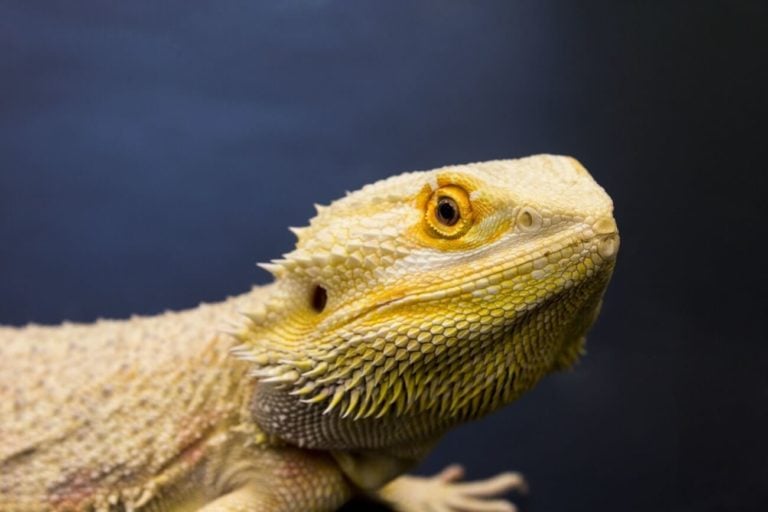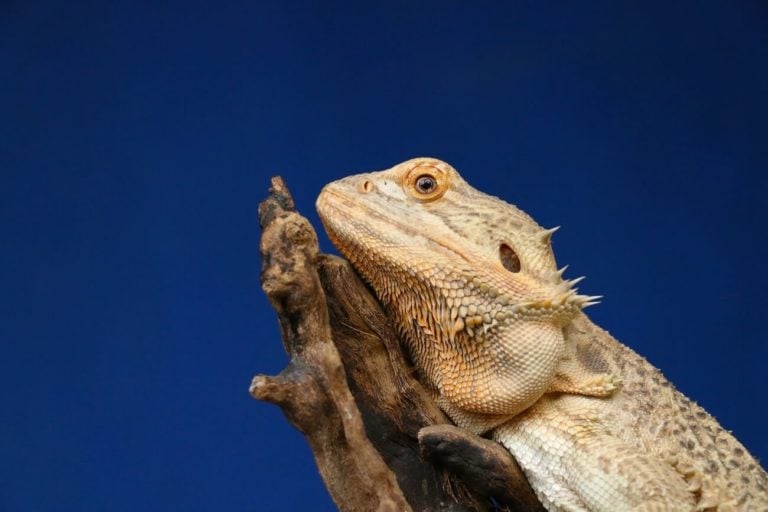There are many types of iguanas out there, but some kinds are more popular than the rest. Some are revered in the wild while others are commonly kept as pets.
We hope you enjoy this list of iguana species! We had a lot of fun putting it together.
1. Green Iguana
When most people think of iguanas, this species is the one that comes to mind. Green iguanas are extremely common pet lizards.
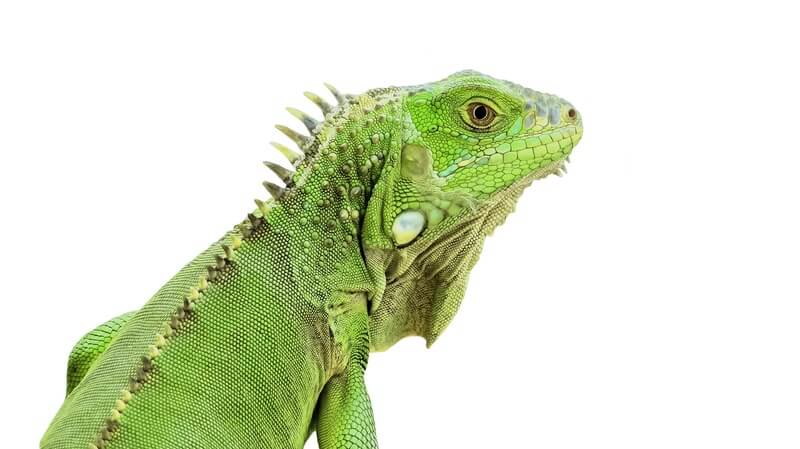
While the common name would imply a signature color, many green iguana colors exist. Dedicated herpetology enthusiasts collect exotic morphs with colors like purple, black, brown, pink, and more.
A fully grown specimen can reach lengths of six or seven feet. They can also tip the scales at 20 pounds or so. Most of the lizard’s body length is all tail. The tail alone can be about three times as long as the snout-to-vent length.
Green iguanas use their tail for defense. It’s often a tool for whipping would-be predators. If faced with possible injury, this iguana species is fully capable of dropping their tail to evade capture, too.
Strong legs, agile fingers, and sharp claws help these reptiles navigate with ease. Meanwhile, the solid jowls and prominent dewlap under the chin provide that signature intimidating look.
Because of their large size, green iguanas require a sizable enclosure. Small terrariums won’t cut it for these tree-dwellers! They need vertically oriented habitats that easily accommodate their size and provide plenty of room for navigation. Not only that, but the lizard prefers to have a network of climbing surfaces for thermoregulation and enrichment.
Despite their popularity, green iguanas can be a bit of a handful for newbies. In addition to their space requirements, this type of iguana is notoriously defensive. They are tamable, but it requires time and trust to get to that point.
2. Fiji Banded Iguana
Fiji banded iguanas are gorgeous reptiles with a much more vibrant look than their most common cousin. Most of the body is covered in bright green. However, thick vertical white, blue, or yellow bands adorn the body and pack a massive visual punch!
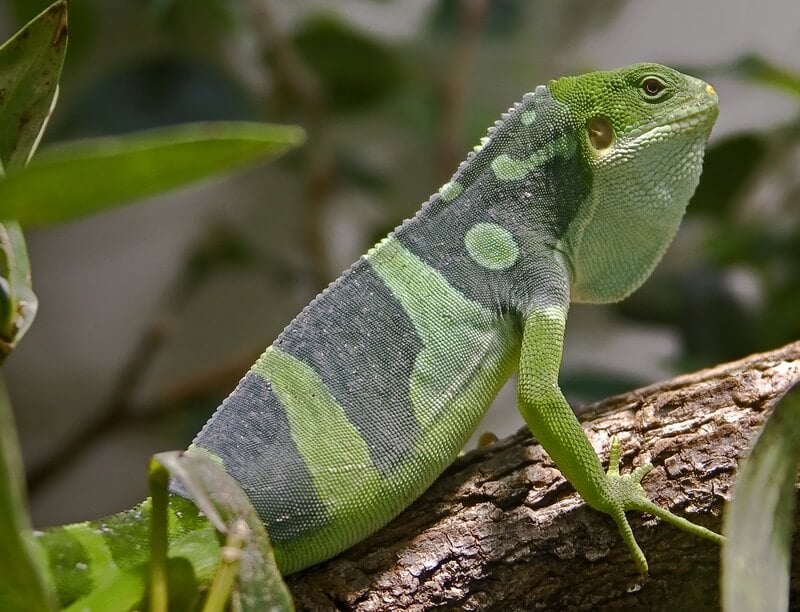
The lizard’s coloration is the start of the show. They lack the pronounced spikes that other species have, resulting in a softer and more approachable appearance.
As their name would imply, Fiji banded iguanas are native to the Fiji Islands. Residents of the archipelago revere them so much that these lizards appear on stamps and local currency!
Unfortunately, Fiji banded iguanas are generally unavailable to hobbyists because of their endangered status. Destruction of their habitat from fires and storms results in dwindling numbers. Wild importation is strictly forbidden, but some dedicated herpetology buffs do breed them in captivity.
This kind of iguana is on the smaller side compared to green iguanas. They reach lengths of about 24 inches and weigh less than a pound when mature.
A diurnal species, these lizards spend most of their basking in the sun and protecting their claimed territory. They’re pretty easy-going and low-key. At night, this type of iguana returns to the safety of treetops to sleep for the night.
Fiji banded iguanas do require sizable enclosures with plenty of vertical climbing space when kept in captivity. They’re predominantly herbivores, but younger lizards can snack on bugs and high-protein snacks from time to time.
3. Desert Iguana
While most iguana species are known for climbing trees and blending into dense tropical foliage, that’s not the case for the desert iguana. This variety is endemic to arid habitats throughout North America. They reside in barren lands exposed to dry heat.
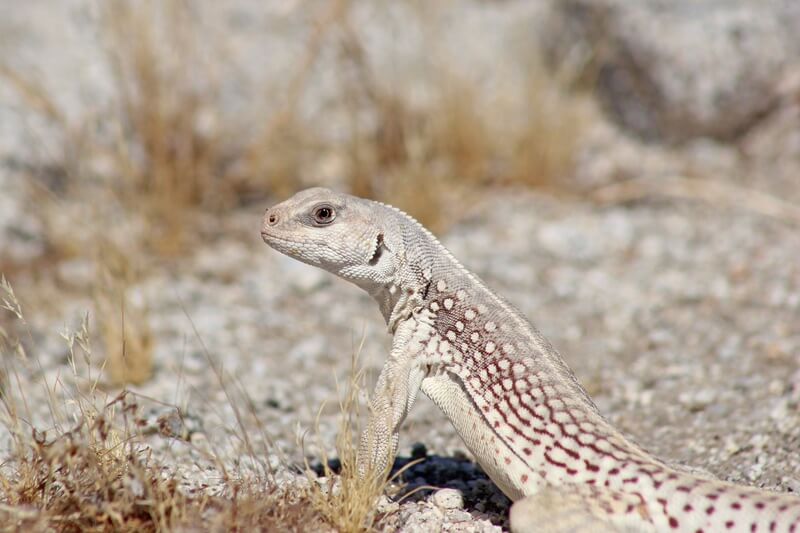
Desert iguanas have a very distinct look. Their natural environment is far from the lush jungles that other lizards are used to, and their physical appearance reflects that. Instead of bright green skin, these reptiles are clad in tan, brown, and gray.
Accents of rusty brown and black are pretty standard, too. Most lizards sport a pattern of broken bands on their back, which helps to camouflage them in their unique surroundings.
Another key difference with this type of iguana is their lack of defined spikes. Some lizards have subtle spikes on the head, but their profiles are pretty smooth and featureless. These guys don’t even have a pronounced dewlap under the chin!
The body is thick and cylindrical. Robust legs support the body and help these iguanas navigate their dry habitats. Desert iguanas are capable of climbing bushes and rocks. However, they don’t scale massive treetops like other types of iguanas.
Instead, they prefer to stay low and find a secure hiding spot when faced with danger.
Desert iguanas are on the rare side in the pet community. Most find it difficult to acclimate to life in captivity. That said, they are a rewarding species to care for once they get comfortable and fall into the routine of living life as a pet.
4. West Indian Rock Iguana
West Indian rock iguanas include a group of about ten different species and several subspecies. They all come from the West Indies. Many of them are classified as critically endangered, making them a rarity in the pet trade.
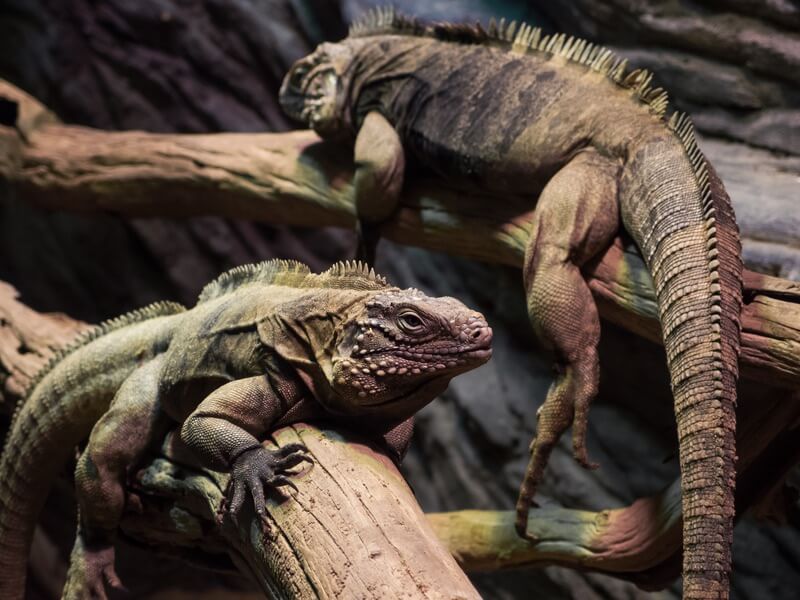
Several species can breed in captivity, which provides a window for skilled herpetology enthusiasts to raise these unique creatures.
West Indian rock iguanas can vary dramatically in size. You have manageable species on the lower end of the size spectrum that max out at about two feet. However, bigger varieties can get over five feet long!
Because this variety encompasses many species, physical appearance varies across the board, too. However, most are beefier and have well-defined features like large spikes, wide jowls, and scaly skin. Colors usually include brown, gray, and black.
Like most larger types of iguanas, West Indian rock varieties need large enclosures to stay healthy. They’re not as arboreal as common green iguanas, but climbing surfaces are still paramount.
When it comes to behavior and temperament, this iguana species can be challenging for newbies. They tend to exhibit signs of aggression and resist handling. If you have the chance to care for one of these lizards from birth, things can be different.
Iguanas that are handled and socialized early on are more accepting of human interaction as adults. However, they will always be unpredictable.
5. Rhinoceros Iguana
This aptly named iguana is easy to recognize the moment you see it! It gets its common name from the bony horn-like projection that grows from the snout. While it does look somewhat intimidating, most don’t use it to fight.
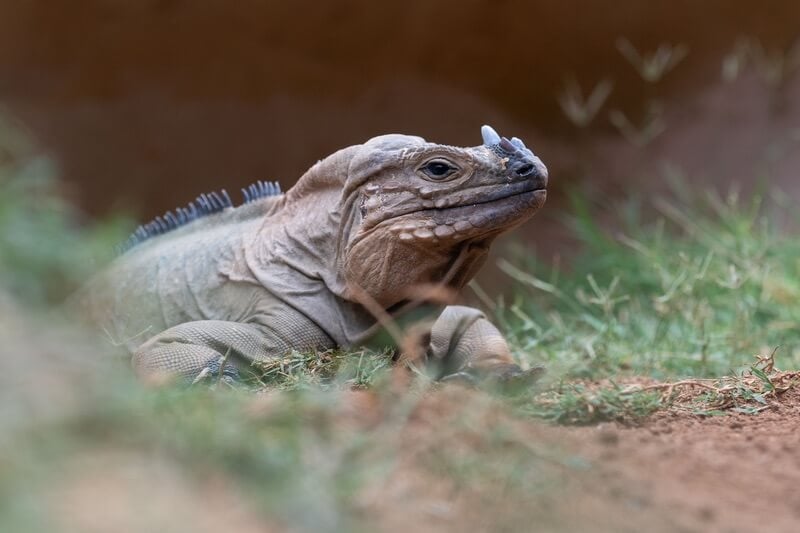
Instead, it helps to protect the lizard from rocks and other hard surfaces.
Rhinoceros iguanas belong to the Cyclura genus of lizards. They’re one of the many West Indian rock iguanas. Native to the Caribbean, this lizard’s natural habitat is slightly different from what most would expect.
These guys are strong, muscular, and large. They can grow to four or five feet long and get as big as 20 pounds. That’s a lot of mass to move around!
Rhinoceros iguanas can climb trees, but they prefer to live between rocks. Here’s where that signature horn comes in handy!
Like other species from the West Indies, rhinoceros iguanas are endangered. They’re rare in the pet scene. However, some dedicated lizard keepers do care for them.
This type of iguana isn’t a good fit for newbies. They have very distinct needs that most casual herpetology fans aren’t capable of handling. The rhino iguana needs an enclosure with a lot of floor space to stay happy.
The good news is that successful iguana keepers can find a lot of joy in caring for this species. Rhinoceros iguanas are some of the most personable once you gain their trust and respect.
6. Galapagos Land Iguana
Two types of iguanas live on the biologically diverse Galapagos island. A few species exist between them, but iguanas on these islands are classified as either marine or land-based.
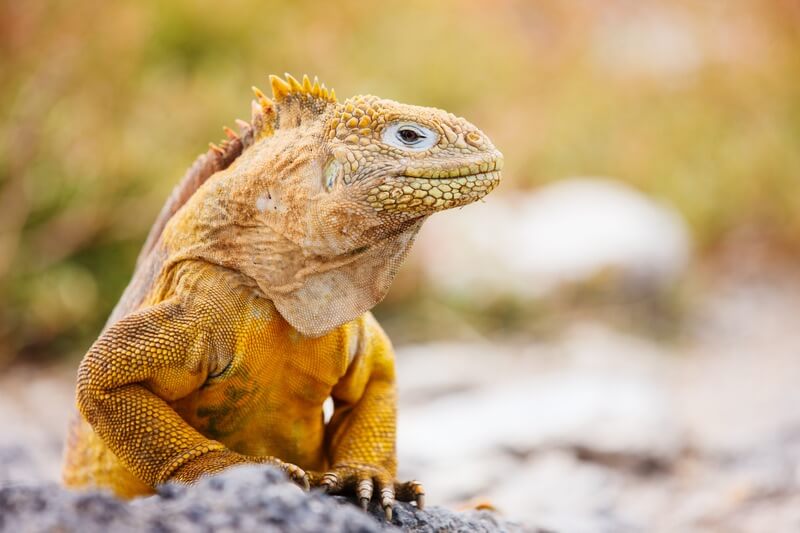
Galapagos land iguanas look very similar to marine species. However, they do not venture into the ocean to forage for food. Instead, they stick to the dry lowland of several islands.
Described as “ugly animals” by Charles Darwin, land iguanas have a “rough around the edges” appearance. They’re not vibrantly colored or sport any remarkable features. The top of the body is usually brownish-red, while the bottom has a burnt orange color.
These lizards are girthy and measure about three feet long when fully grown. They don’t climb too often. Instead, they prefer to bask in the sun or lay on a volcanic rock to regulate their temperature.
Galapagos land iguanas consume a diet that consists of mostly plant matter. However, they will eat insects like centipedes for occasional high-protein snacks. Some also eat the decaying flesh of dead animals.
Interestingly enough, these iguana species have a symbiotic relationship with birds. It’s one of the more fascinating aspects of their lifestyle. The lizards will allow birds to pick parasites and ticks off their body to get relief.
Like other reptiles from the Galapagos islands, these iguanas are unavailable to private keepers. They’re heavily protected, and importation isn’t currently possible.
7. Chuckwalla
Chuckwallas are another variety that challenges the standard iguana mold. They don’t live in tropical regions surrounded by vegetation and trees. Instead, they inhabit arid deserts in the western areas of North America.
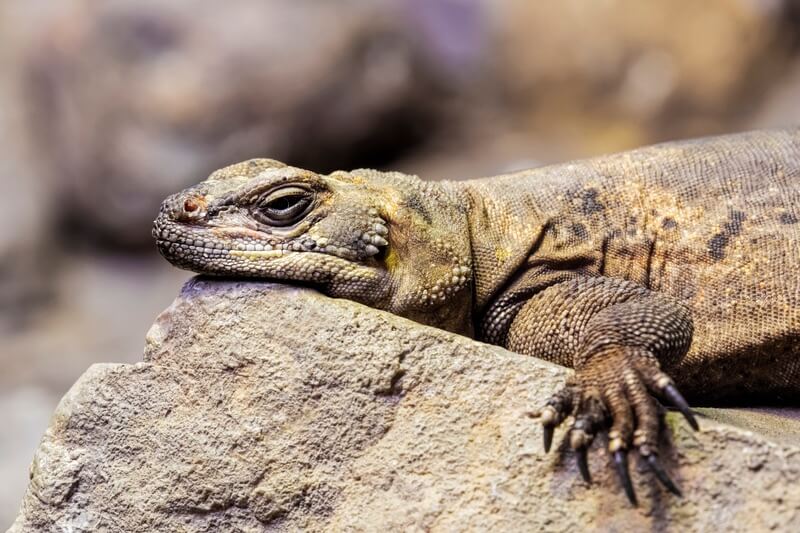
The chuckwalla’s physical appearance reflects its challenging natural environment. Don’t expect to see bright coloration and tons of jewel tone accents. These lizards have evolved to develop dark and protective skin.
Most chuckwallas are black, dark gray, or brown. Not only that, but the skin is usually thick and scaly for added protection against the unforgiving sun!
There are about six or so species in the chuckwalla family. As a whole, this iguana breed is pretty rare in the pet trade. Of the half-dozen species, the common chuckwalla and the Angel Island chuckwalla are the most available to collectors.
Reaching lengths of about 18 inches, chuckwallas aren’t for novice reptile-keepers. These creatures have some steep demands as far as housing goes. The lizard’s stocky body and ground-dwelling lifestyle can be hard to accommodate.
Instead of scaling trees, chuckwallas will hide in rock outcroppings. When chased by a predator, these lizards will squeeze into crevices and fill their bodies with air. As a result, they become lodged in the rock and more difficult for predatory animals to get to.
In captivity, a chuckwalla’s constant need to get away can be hard to handle. This variety is notoriously difficult to tame.
8. Spiny-Tailed Iguana
Spiny-tailed iguanas are native to Mexico and Central America. They live in hot, arid regions. However, they’re also semi-arboreal and need to have several climbing surfaces in their environment to stay healthy.
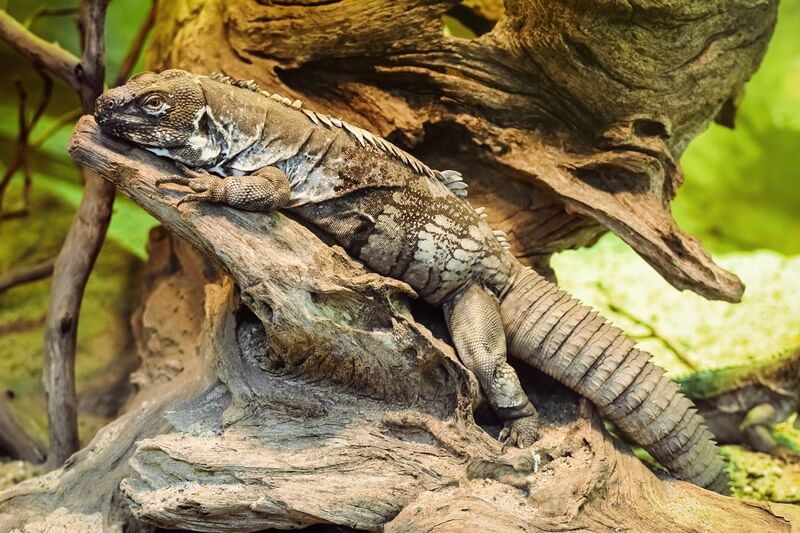
These lizards are not as common as green iguanas. But, dedicated enthusiasts can find captive-bred specimens in the pet trade. Wild imports are not available, as spiny-tailed iguanas are protected animals.
There are more than a dozen species in this family of iguanas, but the black spiny-tailed iguana is the one that’s most widely available to keepers.
Take one look at this reptile, and it’s not hard to see why they have their common name. Thick spikes line the lizard’s back. They start at the neck and continue to the keeled tail.
The most exciting physical feature is the keeled scales that cover the tail. They create an impressive weapon for self-defense. If threatened, this type of iguana will whip its tail back and forth to cause injury. If you’re lucky enough to raise one of these lizards, be prepared to feel the pain of those whips!
Spiny-tailed iguanas have a reputation for having a less-than-ideal temperament. They’re aggressive, flighty, and downright difficult to handle. Many will resort to whipping their tail in defense and biting the hand that feeds. As a result, they’re not ideal for beginners.
9. Grand Cayman Blue Iguana
Grand Cayman blue iguanas (also known simply as blue iguanas) are nothing short of breathtaking. These lizards are a sight to behold because of their sheer size and distinct coloration.
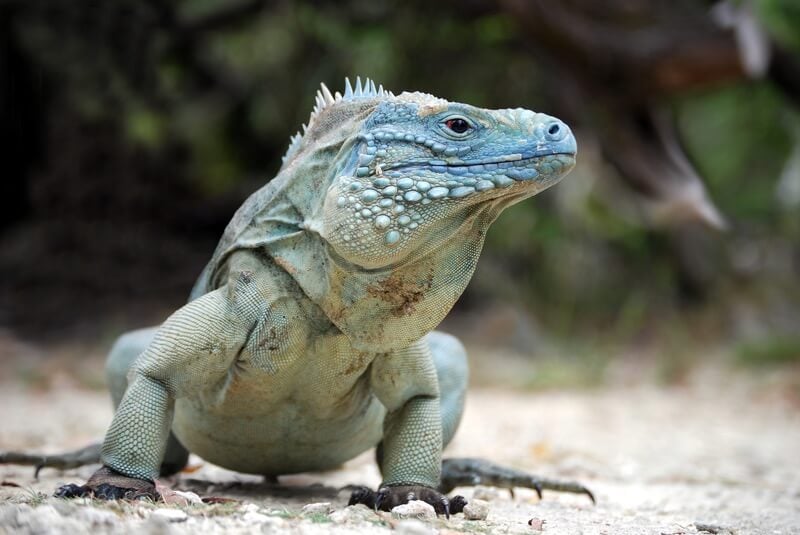
When fully grown, blue iguanas reach five feet and can weigh as much as 30 pounds! They’re one of the largest animals on the Cayman Islands, which is an impressive feat on its own.
Usually, this iguana breed is tan or gray. You might also notice a slightly bluish tint. Whenever the lizard feels threatened, that blue coloration comes out in full force!
The color intensifies as a sign of predominance or danger. Potential predators see the color as hazardous, so it’s a fantastic defense mechanism that helps this lizard climb the food chain.
The Grand Cayman blue iguana isn’t like the slender and agile lizards you see scaling treetops. It’s rather heavy-bodied and prefers to stick to rocky terrains. The reptile can climb, but it’s most likely to use its sharp claws for digging rather than ascending vertical surfaces.
Like other types of iguanas, this creature is sporting large spikes along its back. They complement the massive jowls and scaly skin.
These iguanas aren’t particularly skittish like other varieties. However, they can bite if stressed or frightened. While the teeth are short, they are sharp enough to do some damage if you’re unlucky enough to be on the other end of a bite.
Don’t expect to see many blue iguanas for sale. They’re an endangered lizard that the people of Grand Cayman work to protect.
10. Cuban Rock Iguana
The Cuban rock iguana is a large lizard that’s native to the rocky southern coast of Cuba. It’s the second-largest species to inhabit the West Indies. Unfortunately, they also happen to be one of the most endangered.
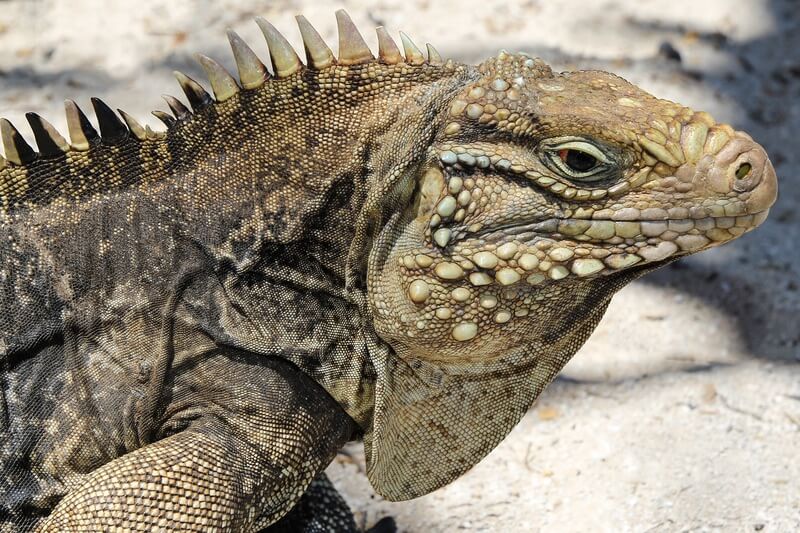
Thanks to the destruction of their natural habitat and the rise of natural predators, Cuban rock iguanas are in danger of extinction. Luckily, efforts to preserve the species are in full swing. Despite their status in the wild, many captive breeding programs exist. Not only that, but these lizards have a significant presence in public and private collections.
Cuban rock iguanas are about 16 inches from snout to vent. Like most types of iguanas, the tail is several the length of the main body. In total, these lizards can measure over five feet long.
Overall, this iguana variety has more mass than common green iguanas. A row of short spines run down the body. Meanwhile, the head is thick and stout. Firm jowls flank the sides while a dewlap hangs below the chin.
The body of the Cuban rock iguana features a combination of brown, gray, and black accents. The coolest part of this species is its eyes. A golden red iris sits in the middle of a deep red sclera.
Largely herbivores, Cuban rock iguanas are pretty easy to feed. They readily consume leafy greens, flowers, and many vegetables. Occasionally, they’ll eat the dead bodies of fish, crabs, and birds in the wild.
While these iguanas do take time to acclimate to their surroundings, they can calm down once tamed. Once they trust keepers and get comfortable with their new habitat, Cuban rock iguanas are relatively easy-going and inquisitive.
Conclusion
The different types of iguanas you can find will never cease to amaze. With so many varieties in appearance and behavior, it’s not a surprise that these reptiles have captivated our attention for ages.
If there’s another type of iguana you think we should add to the list, we’re more than happy to consider it. Just send it over and we’ll take a look.

